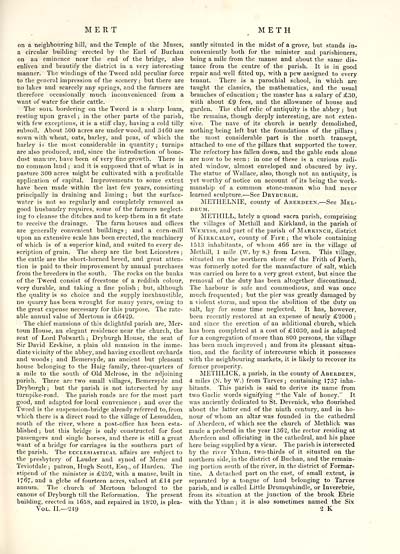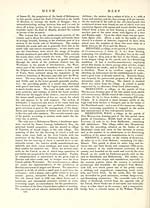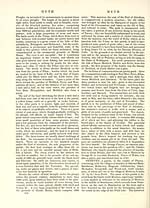Topographical dictionary of Scotland > Volume 2
(257) Page 249
Download files
Complete book:
Individual page:
Thumbnail gallery: Grid view | List view

MERT
METH
on a neighbouring hill, and the Temple of the Muses,
a circular building erected by the Earl of Buchan
on an eminence near the end of the bridge, also
enliven and beautify the district in a very interesting
manner. The windings of the Tweed add peculiar force
to the general impression of the scenery; but there are
no lakes and scarcely any springs, and the farmers are
therefore occasionally much inconvenienced from a
want of water for their cattle.
The soil, bordering on the Tweed is a sharp loam,
resting upon gravel ; in the other parts of the parish,
with few exceptions, it is a stiff clay, having a cold tilly
subsoil. About 500 acres are under wood, and 3460 are
sown with wheat, oats, barley, and peas, of which the
barley is the most considerable in quantity; turnips
are also produced, and, since the introduction of bone-
dust manvre, have been of very fine growth. There is
no common land ; and it is supposed that of what is in
pasture 300 acres might be cultivated with a profitable
application of capital. Improvements to some extent
have been made within the last few years, consisting
principally in draining and liming ; but the surface-
water is not so regularly and completely removed as
good husbandry requires, some of the farmers neglect-
ing to cleanse the ditches and to keep them in a fit state
to receive the drainage. The farm houses and offices
are generally convenient buildings ; and a corn-mill
upon an extensive scale has been erected, the machinery
of which is of a superior kind, and suited to every de-
scription of grain. The sheep are the best Leicesters ;
the cattle are the short-horned breed, and great atten-
tion is paid to their improvement by annual purchases
from the breeders in the south. The rocks on the banks
of the Tweed consist of freestone of a reddish colour,
very durable, and taking a fine polish ; but, although
the quality is so choice and the supply inexhaustible,
no quarry has been wrought for many years, owing to
the great expense necessary for this purpose. The rate-
able annual value of Mertoun is £6429.
The chief mansions of this delightful parish are, Mer-
toun House, an elegant residence near the church, the
seat of Lord Polvvarth ; Dryburgh House, the seat of
Sir David Erskine, a plain old mansion in the imme-
diate vicinity of the abbey, and having excellent orchards
and woods ; and Bemersyde, an ancient but pleasant
house belonging to the Haig family, three-quarters of
a mile to the south of Old Melrose, in the adjoining
parish. There are two small villages, Bemersyde and
Dryburgh ; but the parish is not intersected by any
turnpike-road. The parish roads are for the most part
good, and adapted for local convenience ; and over the
Tweed is the suspension-bridge already referred to, from
which there is a direct road to the village of Lessudden,
south of the river, where a post-office has been esta-
blished ; but this bridge is only constructed for foot
passengers and single horses, and there is still a great
want of a bridge for carriages in the southern part of
the parish. The ecclesiastical aifairs are subject to
the presbytery of Lauder and synod of Merse and
Teviotdale ; patron, Hugh Scott, Esq., of Harden. The
stipend of the minister is £252, with a manse, built in
1*67, and a glebe of fourteen acres, valued at £14 per
annum. The church of Mertoun belonged to the
canons of Dryburgh till the Reformation. The present
building, erected in 1658, and repaired in 1S20, is plea-
Vol. II.— 249
santly situated in the midst of a grove, but stands in-
conveniently both for the minister and parishioners,
being a mile from the manse and about the same dis-
tance from the centre of the parish. It is in good
repair and well fitted up, with a pew assigned to every
tenant. There is a parochial school, in which are
taught the classics, the mathematics, and the usual
branches of education ; the master has a salary of £30,
with about £9 fees, and the allowance of house and
garden. The chief relic of antiquity is the abbey : but
the remains, though deeply interesting, are not exten-
sive. The nave of its church is nearly demolished,
nothing being left but the foundations of the pillars ;
the most considerable part is the north transept,
attached to one of the pillars that supported the tower.
The refectory has fallen down, and the gable ends alone
are now to be seen : in one of these is a curious radi-
ated window, almost enveloped and obscured by ivy.
The statue of Wallace, also, though not an antiquity, is
yet worthy of notice on account of its being the work-
manship of a common stone-mason who had never
learned sculpture. — See Dryburgh.
METHELNIE, county of Aberdeen.— See Mel-
drum.
METHILL, lately a quoad sacra parish, comprising
the villages of Methill and Kirkland, in the parish of
Wemyss, and part of the parish of Markinch, district
of Kirkcaldy, county of Fife ; the whole containing
1513 inhabitants, of whom 466 are in the village of
Methill, 1 mile (W. by S.) from Leven. This village,
situated on the northern shore of the Frith of Forth,
was formerly noted for the manufacture of salt, which
was carried on here to a very great extent, but since the
removal of the duty has been altogether discontinued.
The harbour is safe and commodious, and was once
much frequented ; but the pier was greatly damaged by
a violent storm, and upon the abolition of the duty on
salt, lay for some time neglected. It has, however,
been recently restored at an expense of nearly £2000 ;
and since the erection of an additional church, which
has been completed at a cost of £1030, and is adapted
for a congregation of more than S00 persons, the village
has been much improved ; and from its pleasant situa-
tion, and the facility of intercourse which it possesses
with the neighbouring markets, it is likely to recover its
former prosperity.
METHLICK, a parish, in the county of Aberdeen,
4 miles (N. by W.) from Tarves ; containing 1737 inha-
bitants. This parish is said to derive its name from
two Gaelic words signifying " the Vale of honey." It
was anciently dedicated to St. Devenick, who flourished
about the latter end of the ninth century, and in ho-
nour of whom an altar was founded in the cathedral
of Aberdeen, of which see the church of Methlick was
made a prebend in the year 1362, the rector residing at
Aberdeen and officiating in the cathedral, and his place
here being supplied by a vicar. The parish is intersected
by the river Ythan, two-thirds of it situated on the
northern side, in the district of Buchan, and the remain-
ing portion south of the river, in the district of Formar-
tine. A detached part on the east, of small extent, is
separated by a tongue of land belonging to Tarves
parish, and is called Little Drumquhindle, or Inverebrie,
from its situation at the junction of the brook Ebrie
with the Ythan ; it is also sometimes named the Six
2 K
METH
on a neighbouring hill, and the Temple of the Muses,
a circular building erected by the Earl of Buchan
on an eminence near the end of the bridge, also
enliven and beautify the district in a very interesting
manner. The windings of the Tweed add peculiar force
to the general impression of the scenery; but there are
no lakes and scarcely any springs, and the farmers are
therefore occasionally much inconvenienced from a
want of water for their cattle.
The soil, bordering on the Tweed is a sharp loam,
resting upon gravel ; in the other parts of the parish,
with few exceptions, it is a stiff clay, having a cold tilly
subsoil. About 500 acres are under wood, and 3460 are
sown with wheat, oats, barley, and peas, of which the
barley is the most considerable in quantity; turnips
are also produced, and, since the introduction of bone-
dust manvre, have been of very fine growth. There is
no common land ; and it is supposed that of what is in
pasture 300 acres might be cultivated with a profitable
application of capital. Improvements to some extent
have been made within the last few years, consisting
principally in draining and liming ; but the surface-
water is not so regularly and completely removed as
good husbandry requires, some of the farmers neglect-
ing to cleanse the ditches and to keep them in a fit state
to receive the drainage. The farm houses and offices
are generally convenient buildings ; and a corn-mill
upon an extensive scale has been erected, the machinery
of which is of a superior kind, and suited to every de-
scription of grain. The sheep are the best Leicesters ;
the cattle are the short-horned breed, and great atten-
tion is paid to their improvement by annual purchases
from the breeders in the south. The rocks on the banks
of the Tweed consist of freestone of a reddish colour,
very durable, and taking a fine polish ; but, although
the quality is so choice and the supply inexhaustible,
no quarry has been wrought for many years, owing to
the great expense necessary for this purpose. The rate-
able annual value of Mertoun is £6429.
The chief mansions of this delightful parish are, Mer-
toun House, an elegant residence near the church, the
seat of Lord Polvvarth ; Dryburgh House, the seat of
Sir David Erskine, a plain old mansion in the imme-
diate vicinity of the abbey, and having excellent orchards
and woods ; and Bemersyde, an ancient but pleasant
house belonging to the Haig family, three-quarters of
a mile to the south of Old Melrose, in the adjoining
parish. There are two small villages, Bemersyde and
Dryburgh ; but the parish is not intersected by any
turnpike-road. The parish roads are for the most part
good, and adapted for local convenience ; and over the
Tweed is the suspension-bridge already referred to, from
which there is a direct road to the village of Lessudden,
south of the river, where a post-office has been esta-
blished ; but this bridge is only constructed for foot
passengers and single horses, and there is still a great
want of a bridge for carriages in the southern part of
the parish. The ecclesiastical aifairs are subject to
the presbytery of Lauder and synod of Merse and
Teviotdale ; patron, Hugh Scott, Esq., of Harden. The
stipend of the minister is £252, with a manse, built in
1*67, and a glebe of fourteen acres, valued at £14 per
annum. The church of Mertoun belonged to the
canons of Dryburgh till the Reformation. The present
building, erected in 1658, and repaired in 1S20, is plea-
Vol. II.— 249
santly situated in the midst of a grove, but stands in-
conveniently both for the minister and parishioners,
being a mile from the manse and about the same dis-
tance from the centre of the parish. It is in good
repair and well fitted up, with a pew assigned to every
tenant. There is a parochial school, in which are
taught the classics, the mathematics, and the usual
branches of education ; the master has a salary of £30,
with about £9 fees, and the allowance of house and
garden. The chief relic of antiquity is the abbey : but
the remains, though deeply interesting, are not exten-
sive. The nave of its church is nearly demolished,
nothing being left but the foundations of the pillars ;
the most considerable part is the north transept,
attached to one of the pillars that supported the tower.
The refectory has fallen down, and the gable ends alone
are now to be seen : in one of these is a curious radi-
ated window, almost enveloped and obscured by ivy.
The statue of Wallace, also, though not an antiquity, is
yet worthy of notice on account of its being the work-
manship of a common stone-mason who had never
learned sculpture. — See Dryburgh.
METHELNIE, county of Aberdeen.— See Mel-
drum.
METHILL, lately a quoad sacra parish, comprising
the villages of Methill and Kirkland, in the parish of
Wemyss, and part of the parish of Markinch, district
of Kirkcaldy, county of Fife ; the whole containing
1513 inhabitants, of whom 466 are in the village of
Methill, 1 mile (W. by S.) from Leven. This village,
situated on the northern shore of the Frith of Forth,
was formerly noted for the manufacture of salt, which
was carried on here to a very great extent, but since the
removal of the duty has been altogether discontinued.
The harbour is safe and commodious, and was once
much frequented ; but the pier was greatly damaged by
a violent storm, and upon the abolition of the duty on
salt, lay for some time neglected. It has, however,
been recently restored at an expense of nearly £2000 ;
and since the erection of an additional church, which
has been completed at a cost of £1030, and is adapted
for a congregation of more than S00 persons, the village
has been much improved ; and from its pleasant situa-
tion, and the facility of intercourse which it possesses
with the neighbouring markets, it is likely to recover its
former prosperity.
METHLICK, a parish, in the county of Aberdeen,
4 miles (N. by W.) from Tarves ; containing 1737 inha-
bitants. This parish is said to derive its name from
two Gaelic words signifying " the Vale of honey." It
was anciently dedicated to St. Devenick, who flourished
about the latter end of the ninth century, and in ho-
nour of whom an altar was founded in the cathedral
of Aberdeen, of which see the church of Methlick was
made a prebend in the year 1362, the rector residing at
Aberdeen and officiating in the cathedral, and his place
here being supplied by a vicar. The parish is intersected
by the river Ythan, two-thirds of it situated on the
northern side, in the district of Buchan, and the remain-
ing portion south of the river, in the district of Formar-
tine. A detached part on the east, of small extent, is
separated by a tongue of land belonging to Tarves
parish, and is called Little Drumquhindle, or Inverebrie,
from its situation at the junction of the brook Ebrie
with the Ythan ; it is also sometimes named the Six
2 K
Set display mode to: Large image | Transcription
Images and transcriptions on this page, including medium image downloads, may be used under the Creative Commons Attribution 4.0 International Licence unless otherwise stated. ![]()
| Gazetteers of Scotland, 1803-1901 > Topographical dictionary of Scotland > Volume 2 > (257) Page 249 |
|---|
| Permanent URL | https://digital.nls.uk/97364214 |
|---|
| Description | Volume II: From Keanlochbervie to Zetland. |
|---|---|
| Attribution and copyright: |
|

